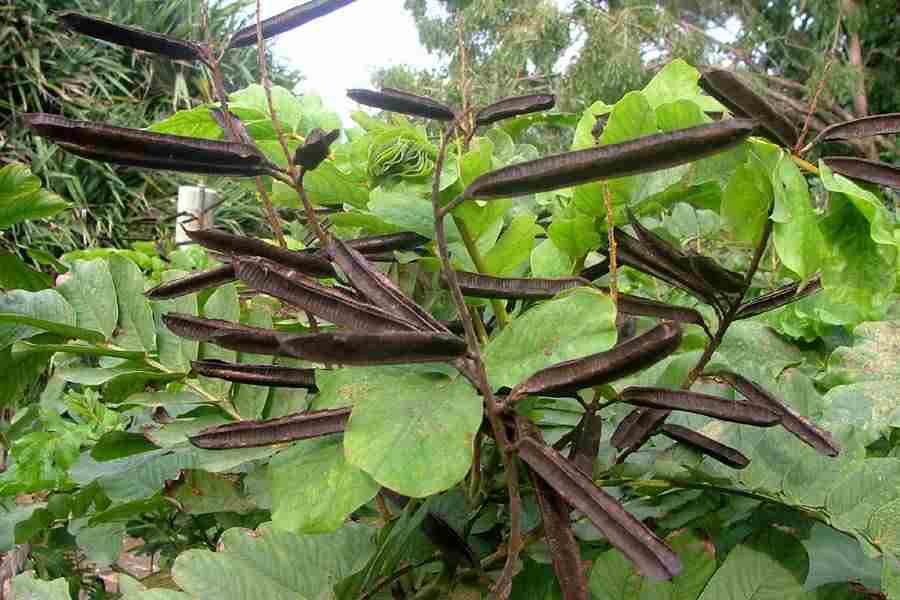Senna alata (L) Roxb.
| Botanical Name | Senna alata (L) Roxb. |
| Order: | Fabales |
| Family: | Fabaceae |
| Genus: | Senna |
| Species: | S. alata |
| Common Names: | Ringworm shrub, Craw-craw plant, King of the forest, Candle stick cassia; ringworm senna; guajava; ringworm bush; seven-golden- candlesticks; Emperor's candlesticks; Empress- candle plant; christmas-candle; candlestick senna; candle bush, fleur St Ch |
Plant Synonyms
Cassia alata L., Hepetica alata Ref., Cassia bracteata L; Cassia herpetica Jacq.
Plant Local Names
Ghana: Twi - Osempe, Ga Adangbe - Bayisa, Ewe - Agbobladzoe
Nigerian: Yoruba - Asunwon oyinbo, Hausa - Majamfari, Ibo - Ogalu
Niger: Hausa - Sanga Sanga
Togo: Ewe - Zangarati, Ouatchi - Zanguerati, Adja - Zangalati
Plant Habitat
Native to America but now found widely distributed throughout the tropics including West Africa from Senegal to Nigeria (Irvine, 1961). It is a common plant in villages, wastelands, clearings and homes; cultivated or spontaneous. In Nigeria it can be found in the rain forest and the savannah, both in the southern and northern parts of the country (Elujoba and Ogunti, 1993; Adjanohoun et al., 1991).
Plant Material of Interest
Dried leaflets, Flower; root; seed; bark
Plant Description
It is a soft-wooded shrub, highly decorative with an unusual and interesting appearance, about 3 m or more in height; leaves are compound pinnate consisting of 8-14 pairs of oblong to obovate leaflets (5-16 cm long by 3-8 cm wide) which are rounded at the end; rachis narrowly winged with a ridge connecting the leaflets; petiole and rachis are up to 60 cm in length; plant flowers in February and October to November; flowers in crest terminal cymes, producing golden yellow flowers in stout, dense, erect and large, spike-like racemes with fertile stamen; fruit, with four broad crenate wings along the middle, straight, winged along sides, contains«*30-40 seeds per fruit, measures 15-25 cm long and about 1.8 cm broad, green when unripe and black when ripe (Adjanohoun et al., 1991).
Plant Used Parts
Plant Uses
The leaves are used for dermatitis, eczema, ringworm, intestinal helminthiasis, taeniasis, constipation, asthma, gonorrhoea, bronchitis, delayed labour and as an abortifacient (Oliver- Bever, 1986; Hauptman and Lacerda, 1950).
Plant Therapeutic Action
Antidiarhoeal, antibacterial, antifungal, antiviral
Plant Precaution for Use
High doses may affect the absorption of other drugs due to reduction in intestinal transit time. Use in nursing mothers, children under 10 years and for more than 2 weeks, would require medical supervision. As with all anthranoid glycoside-containing herbs, long-term use may cause pigmentation of the intestinal mucosa, also provoke nausea and vomiting in large doses.
Plant Adverse Effect
Diarrhoea
Plant Contraindication
Contraindicated in pregnancy and lactation; rectal bleeding, appendicitis and intestinal obstruction and stenosis; high doses may cause gripping, colic, abdominal discomfort, diarrhoea, loss of electrolytes and dehydration; inflammatory bowel disorders; idiopathic abdominal pains; haemorrhoids; colitis and ulcer.
Plant Dosage Forms
Tincture; infusion (tea); decoction Infusion: (hot or cold):
Plant Dosage
The dried pods or leaves should be steeped in warm water for 6-12 hours; 1 teaspoon in about. 150 ml of water; filter after 10 minutes; take one cup in the morning and/or before going to the bed.
Powder: 1-2 g with 150 ml of water (as purgative) Tincture: 1:5 in 50% alcohol; take 2-4 ml at bedtime.
Laxative: 3 - 4g as hot infusion at bedtime Skin infections; 1-2% powder, incorporated into soap or body cream.
Plant Storage
Store in a cool dry place
Plant Chromatographic Fingerprint
Analytical TLC on silica gel G60 F254, 0.25 mm layer in petroleum ether (40-60 °C)/chloroform [2:8], detection in daylight, after spraying with anisaldehyde (0.5 ml) mixed with 10 ml glacial acetic acid, 85 ml methanol and 5ml concentrated sulphuric acid and heated to 100- 110°C for 5-10 min. Presence of characteristic six spots with R,s of 0.96 (pink), 0.93 (pink), 0.71 (pink), 0.53 (pink), 0.47 (brown) and 0.38 (pink).
Plant Constituents
Anthraquinones: aloe-emodin, rhein glycoside and aloe-emodin glycoside, sennosides, rhein, chrysophanic acid; tannins and mucilage (Elujoba et al, 1989; Rai and Adbullahi, 1978; Ogunti etal, 1991; GHP, 1992; Gupta, 1991).
Plant References
Adjanohoun, E. ef a/., (1991). Contribution to Ethnobotanical and Floristic studies in Western Nigeria Lagos, Nigeria: Organization of African Unity's Scientific Technical and Research Commission.
Assane, M., (1993). Choleretic effects of Cassia alata Linn, in the rat. Dakar Medical.; 38(1 ):73- 77.
Benjamin, T.V., Lamikanra, A. (1981). Quarterly Journal of Crude Drug research 19: 93-96.
Crockett, C.O. (1992). Cassia alata and the preclinical search for therapeutic agents for the treatment of opportunistic infections in AIDS patients. Cell and Molecular Biology 38(5):505- 511.
Damodaran, S., Venkataraman, S. (1994). A study on the therapeutic efficacy of Cassia alata, Linn, leaf extract against Pityriasis versicolor. Journal of Ethnopharmacology 42(1):19-23.
Elujoba, A. A., Ogunti, E.O. (1993). Pharmacopoeial and biological standardization of Cassia alata and Cassia podocarpa with reference to Senna. Glimpses in Plant Research XI, 469-479.
Elujoba, A.A., Ajulo, O.O., Iweibo, G.O. (1989). Chemical and Biological analyses of Nigerian
Cassia species for laxative activity. Journal of Pharmaceutical and Biomedical Analysis 7(12):1453 - 1457.
Ghana Herbal Pharmacopoeia (1992). The Advent Press: Accra, Ghana.
Gupta, D. (1991). Flavonoid glycosides from Cassia alata. Phytochemistry 30(8): 2761-2763.
Hauptman, H., Lacerda, V.L. (1950). Journal of American Chemical Society 72: 1492.
Ibrahim, D. (1995). Antimicrobial activity of Cassia alata from Malaysia. Journal of Ethnopharmacology.; 45(3):151 -156.

